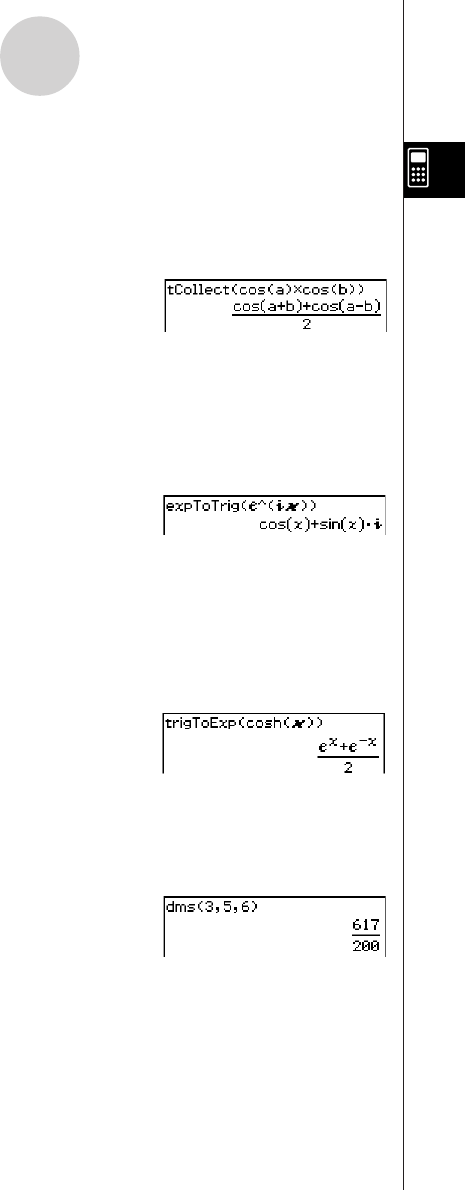Calculator User's Guide
Table Of Contents
- Getting Ready
- Contents
- About This User’s Guide
- Chapter 1 Getting Acquainted
- Chapter 2 Using the Main Application
- 2-1 Main Application Overview
- 2-2 Basic Calculations
- 2-3 Using the Calculation History
- 2-4 Function Calculations
- 2-5 List Calculations
- 2-6 Matrix and Vector Calculations
- 2-7 Using the Action Menu
- 2-8 Using the Interactive Menu
- 2-9 Using the Main Application in Combination with Other Applications
- 2-10 Using Verify
- Chapter 3 Using the Graph & Table Application
- Chapter 4 Using the Conics Application
- Chapter 5 Using the 3D Graph Application
- Chapter 6 Using the Sequence Application
- Chapter 7 Using the Statistics Application
- 7-1 Statistics Application Overview
- 7-2 Using List Editor
- 7-3 Before Trying to Draw a Statistical Graph
- 7-4 Graphing Single-Variable Statistical Data
- 7-5 Graphing Paired-Variable Statistical Data
- 7-6 Using the Statistical Graph Window Toolbar
- 7-7 Performing Statistical Calculations
- 7-8 Test, Confidence Interval, and Distribution Calculations
- 7-9 Tests
- 7-10 Confidence Intervals
- 7-11 Distribution
- 7-12 Statistical System Variables
- Chapter 8 Using the Geometry Application
- Chapter 9 Using the Numeric Solver Application
- Chapter 10 Using the eActivity Application
- Chapter 11 Using the Presentation Application
- Chapter 12 Using the Program Application
- Chapter 13 Using the Spreadsheet Application
- Chapter 14 Using the Setup Menu
- Chapter 15 Configuring System Settings
- 15-1 System Setting Overview
- 15-2 Managing Memory Usage
- 15-3 Using the Reset Dialog Box
- 15-4 Initializing Your ClassPad
- 15-5 Adjusting Display Contrast
- 15-6 Configuring Power Properties
- 15-7 Specifying the Display Language
- 15-8 Specifying the Font Set
- 15-9 Specifying the Alphabetic Keyboard Arrangement
- 15-10 Optimizing “Flash ROM”
- 15-11 Specifying the Ending Screen Image
- 15-12 Adjusting Touch Panel Alignment
- 15-13 Viewing Version Information
- Chapter 16 Performing Data Communication
- Appendix

20050501
2-7-7
Using the Action Menu
uu
uu
u tCollect
Function: Employs the product to sum formulas to transform the product of a
trigonometric function into an expression in the sum form.
Syntax: tCollect (Exp/Eq/Ineq/List/Mat [
)
]
• Ineq (inequality) includes the “⫽” (not equal to) relational operator.
Example: To transform cos(a) × cos(b) into an expression in the sum form
Menu Item: [Action][Transformation][tCollect]
uu
uu
u expToTrig
Function: Transforms an exponent into a trigonometric or hyperbolic function.
Syntax: expToTrig (Exp/Eq/Ineq/List/Mat [
)
]
• Ineq (inequality) includes the “⫽” (not equal to) relational operator.
Example: To transform e
ix
into a trigonometric function (Radian mode)
Menu Item: [Action][Transformation][expToTrig]
uu
uu
u trigToExp
Function: Transforms a trigonometric or hyperbolic function into exponential form.
Syntax: trigToExp (Exp/Eq/Ineq/List/Mat [
)
]
• Ineq (inequality) includes the “⫽” (not equal to) relational operator.
Example: To transform coshx into exponential form
Menu Item: [Action][Transformation][trigToExp]
uu
uu
u dms
Function: Transforms a DMS format value into its equivalent degrees-only value.
Syntax: dms (Exp/List-1 [,Exp/List-2][,Exp/List-3] [
)
]
Example: To transform (3, 5, 6) (= 3
q
5’ 6”) into its equivalent degrees-only value
Menu Item: [Action][Transformation][dms]
• Zero is the default when you omit [,Exp/List-2] or [,Exp/List-3][
)
].










